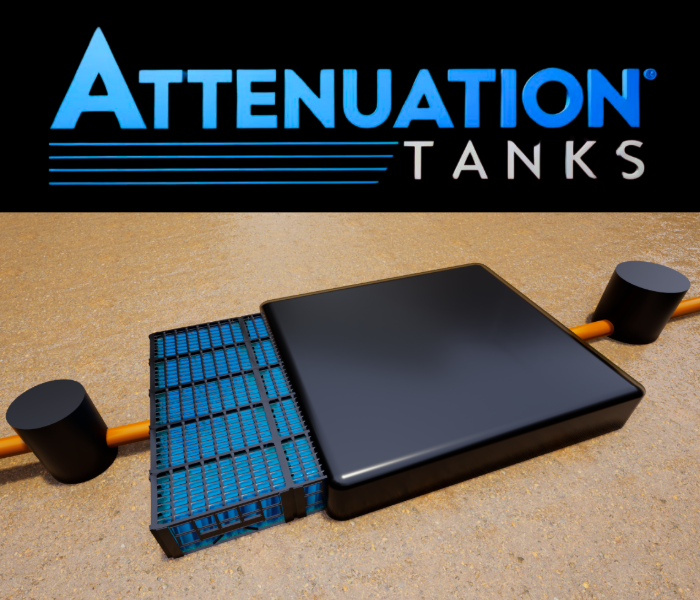Attenuation Tank: Comprehensive Guide for Engineers and Drainage Professionals
As urbanisation and climate-driven rainfall intensify, the need for effective stormwater management is critical for UK engineers, drainage technicians, and urban planners. Consequently, an
attenuation tank serves as a vital tool, storing excess stormwater and releasing it slowly to prevent flooding. With a reported 5% rise in rainfall from 2009–2018 compared to 1961–1990 (
Met Office), traditional drainage systems are increasingly inadequate, leading to infrastructure damage and environmental degradation. Therefore, attenuation tanks, as a cornerstone of Sustainable Drainage Systems (SuDS), offer a robust solution, mitigating flood risks and ensuring regulatory compliance.
This 10,000-word guide provides an authoritative resource for drainage industry professionals, covering the science, design, installation, maintenance, and regulatory landscape of attenuation tanks. Furthermore, through detailed technical insights, case studies, a white paper, and practical recommendations, we aim to empower you to implement these systems effectively. At
Builders Yard UK, we specialize in cost-effective, durable attenuation tank solutions, saving up to £40,000 compared to traditional drainage systems. Explore our offerings at
Builders Yard Attenuation Tanks and
Attenuation Tank UK to enhance your project’s stormwater strategy.
Understanding the Attenuation Tank
Definition and Purpose of an Attenuation Tank
An
attenuation tank is an underground storage system engineered to capture and temporarily hold stormwater runoff during heavy rainfall, releasing it at a controlled rate to prevent flooding and reduce peak flow into drainage networks. As a critical component of SuDS, these tanks mimic natural drainage processes, addressing the challenges of urban runoff and climate change. For instance, they are particularly vital in areas with impermeable surfaces, such as roads, car parks, and rooftops, where runoff volumes are high, and in regions with low soil permeability, like clay-heavy soils, where infiltration is limited.
Moreover, the primary purpose of an attenuation tank is to manage stormwater quantity, ensuring that drainage systems and watercourses are not overwhelmed during storm events. By storing water and releasing it slowly, these tanks reduce the risk of localized flooding, protect infrastructure, and comply with stringent UK regulations, such as the
Flood and Water Management Act 2010.
Types of Attenuation Tanks
Attenuation tanks come in various forms, each tailored to specific project requirements and site conditions. Consequently, the main types include:
- Modular Plastic Crate Systems: Constructed from recycled polypropylene, these lightweight, modular units offer high void ratios (up to 97%), maximizing storage efficiency. They are cost-effective, easy to install, and ideal for residential, commercial, and small industrial projects. Their flexibility allows adaptation to various site shapes and sizes.
- Pre-Fabricated Concrete Tanks: Known for their durability and high load-bearing capacity, concrete tanks are suited for large-scale developments, such as airports, highways, and industrial estates. They can withstand heavy traffic loads and have a design life exceeding 100 years, as noted by FLI Precast Solutions.
- Fibreglass Tanks: Offering corrosion resistance and moderate load capacity, fibreglass tanks balance durability and installation ease. They are suitable for medium to large projects where soil conditions or environmental factors require robust materials.
- Pipe-Based Systems: Large-diameter plastic or concrete pipes provide linear storage, often used in road projects or constrained spaces. They are effective for managing runoff along linear routes.
- Hybrid Systems: Combining crates, tanks, or other SuDS components, hybrid systems offer customized solutions for complex sites, optimizing storage and flow control.
At
Builders Yard UK, our modular crate systems are a preferred choice for their affordability, scalability, and compliance with
Defra’s Non-Statutory Technical Standards, making them versatile for diverse applications.
Evolution of the Attenuation Tank
The development of attenuation tanks traces back to early stormwater management practices that relied on concrete culverts and pipes, which were costly and space-intensive. However, in the late 20th century, as urban flooding became a pressing issue, modular plastic crate systems emerged, offering a lightweight, flexible alternative. Furthermore, advances in materials, such as recycled polypropylene, and innovations like integrated flow controls have enhanced their efficiency and sustainability. Today, attenuation tanks are a cornerstone of SuDS, driven by regulatory mandates and the need for resilient infrastructure, as highlighted by industry leaders like
GRAF UK.
Science of the Attenuation Tank
Operational Mechanism of Attenuation Tanks
Attenuation tanks operate through a three-stage process rooted in hydrological principles, ensuring effective stormwater management:
- Collection: Stormwater from impermeable surfaces is channeled into the tank via drainage inlets, such as gullies or pipes. For example, the design of inlets must account for the site’s catchment area and expected runoff volumes, calculated using methods like the Rational Method (Q = C * I * A, where Q is peak discharge, C is runoff coefficient, I is rainfall intensity, and A is drainage area).
- Storage: The tank’s void space temporarily holds the water. Consequently, modular crate systems, like those from Builders Yard UK, offer high void ratios (up to 97%), allowing significant storage with minimal material. For instance, a single crate can store 200 liters, scalable to meet project needs.
- Controlled Release: A flow control device, such as an orifice plate or vortex flow control (e.g., FlowBrake), regulates the discharge rate, typically set to greenfield runoff rates (2–5 liters/second/hectare). Thus, this prevents downstream flooding and erosion, as per Defra standards.
In permeable systems, tanks may facilitate infiltration into the soil, recharging groundwater, with geotextile or geomembrane liners preventing soil ingress while allowing water flow, as recommended by the
CIRIA SuDS Manual.
Design Considerations for Attenuation Tanks
Designing an effective attenuation tank requires integrating hydrological, structural, and environmental factors. Therefore, key considerations include:
- Site Assessment: Evaluate topography, soil permeability, groundwater levels, and existing drainage infrastructure. For example, a percolation test determines infiltration rates, critical for permeable systems.
- Hydraulic Calculations: Calculate storage volume using the Rational Method or Modified Rational Method, incorporating rainfall data and climate change allowances (20–40% increase for 2061–2125, per Defra).
- Structural Design: Ensure tanks withstand loads, especially under trafficked areas. Moreover, modular crates support up to 60 tonnes, while concrete tanks offer higher capacity, per Hewitech.
- Inlet and Outlet Design: Size and position inlets/outlets to optimize flow and prevent blockages. Consequently, flow control devices must match allowable discharge rates set by local authorities.
- Water Quality Measures: Include sediment traps or filters to remove pollutants, improving discharge quality.
- Maintenance Access: Design for easy inspection via access shafts or chambers, ensuring long-term performance.
The CIRIA C680 standard, with a 2.75 material safety factor, guides load assessments, ensuring structural integrity under various conditions.
Technical Specifications for Stormwater Tanks
Attenuation tanks vary in specifications based on project needs. As a result, common parameters include:
- Storage Capacity: From 200 liters per crate to thousands of cubic meters for large tanks.
- Void Ratio: Up to 97% for modular crates, maximizing storage efficiency.
- Load Capacity: From 20 tonnes for light traffic to over 60 tonnes for heavy vehicles.
- Material: Recycled polypropylene, concrete, or fibreglass, each with distinct advantages.
- Lifespan: Over 50 years with proper maintenance, per GRAF UK.
Our SuDS tanks at
Builders Yard UK meet these specifications, offering reliable solutions for diverse applications.
Why Attenuation Tanks Are Essential
Climate Change and Increased Rainfall
Climate change has intensified UK rainfall, with a 5% increase from 2009–2018 compared to 1961–1990 (
Met Office). Consequently, more frequent and severe storms overwhelm traditional drainage systems, causing urban flooding costing £320 million annually, per the Flood and Coastal Defence project cited by
FLI Precast Solutions. Therefore, attenuation tanks mitigate these risks by storing excess runoff and releasing it at controlled rates, protecting infrastructure and communities.
Urbanisation and Impermeable Surfaces
Rapid urbanisation has increased impermeable surfaces, amplifying runoff volumes. As a result,
Susdrain notes this exacerbates flooding in cities with outdated drainage systems. For instance, attenuation tanks store runoff underground, preserving surface land for development, making them ideal for urban projects.
Regulatory Drivers for SuDS Tanks
UK regulations drive attenuation tank adoption. Specifically, the
Flood and Water Management Act 2010 mandates SuDS, with Schedule 3 enforcing this in England from 2024, per
Clyde & Co. Additionally, the
NPPF requires SuDS for major developments, ensuring runoff is managed at greenfield rates. Thus, local authorities enforce these standards, making tanks essential for compliance.
Environmental and Economic Benefits of Attenuation Tanks
Attenuation tanks offer significant benefits:
- Water Quality Improvement: Filters remove pollutants, protecting watercourses (NetRegs).
- Groundwater Recharge: Permeable systems support aquifers.
- Cost Savings: Up to £40,000 savings compared to traditional drainage, per JDP.
- Property Protection: Reduced flood damage enhances property value.
Design and Installation of Attenuation Tanks
Site Assessment for Stormwater Tanks
Effective design begins with a comprehensive site assessment, evaluating topography, soil permeability, groundwater levels, and drainage infrastructure. For example, a percolation test determines infiltration rates, guiding the choice between permeable and sealed systems.
Calculating Storage Requirements for Attenuation Tanks
Storage volume is calculated using hydrological models like the Rational Method (Q = C * I * A) or Modified Rational Method, incorporating rainfall data and climate change allowances. Consequently, software like Micro Drainage ensures accuracy, per
CIRIA.
Installation Process
Installation involves:
- Excavation: Dig to the required depth (500mm–1000mm for crates), ensuring a level base.
- Base Preparation: Lay compacted gravel or sand for stability.
- Installation: Assemble crates or place tanks, wrapping with geotextile or geomembrane liners.
- Pipe Connections: Connect inlets and outlets, ensuring proper flow paths.
- Flow Control: Install devices to regulate discharge rates.
- Backfilling: Use suitable materials, compacting in layers.
- Inspection: Verify compliance with Building Control.
Our team at
Builders Yard UK provides expert installation support, ensuring compliance and performance.
Maintenance and Longevity of Attenuation Tanks
Attenuation tanks require minimal maintenance but regular care ensures longevity:
- Inspections: Check for blockages in pipes and silt traps annually.
- Silt Removal: Clear sediment every 1–2 years, per GRAF UK.
- Liner Checks: Inspect geotextile or geomembrane liners for damage.
- Flow Control Maintenance: Ensure devices function correctly.
With proper maintenance, tanks can last over 50 years, offering long-term reliability.
Case Studies for Attenuation Tank Projects
Central London High Rise
In 2018, a landmark London building installed an 80,000-liter concrete attenuation tank, relined with Acothane DW Polyurethane for durability. Consequently, the project, completed by
Covac, issued a 10-year guarantee, showcasing concrete tanks’ longevity in urban settings.
Public Open Space in Leeds
DXI Regeneration constructed a 5,800 m³ attenuation tank wrapped in 1mm LLDPE in a Leeds public space. Furthermore, connected via 1800mm concrete pipes with a hydrobrake, the tank managed runoff effectively, per
DXI Regeneration.
Comparison with Other SuDS Components
Attenuation tanks are often compared to soakaways, permeable pavements, and swales:
- Soakaways: Infiltrate water into the ground, suitable for permeable soils (JDP).
- Permeable Pavements: Reduce runoff at the source, complementing tanks.
- Swales: Convey and filter water, directing runoff to tanks.
Future Trends in Attenuation Tank Technology
Emerging trends include smart monitoring with IoT sensors, sustainable materials, and designs for climate change adaptation, per
GRAF UK.
White Paper: Attenuation Tanks in Modern Urban Planning
Abstract: This white paper examines the role of attenuation tanks in urban planning, covering design, implementation, and benefits.
Introduction: Urbanization and climate change necessitate advanced stormwater solutions. Consequently, attenuation tanks are pivotal in SuDS, reducing flood risks.
Design and Modeling: Use hydrological models like the Rational Method for sizing, incorporating climate change allowances.
Benefits: Flood prevention, compliance, and environmental protection.
Conclusion: Tanks are essential for sustainable urban development.
Frequently Asked Questions (FAQ) About Attenuation Tanks
- What is an attenuation tank?
- An attenuation tank stores stormwater and releases it slowly to prevent flooding, a key SuDS component (CIRIA).
- How do attenuation tanks differ from soakaways?
- Tanks store and release water to drainage systems, while soakaways infiltrate water into the ground (JDP).
- What regulations apply to attenuation tanks?
- The Flood and Water Management Act 2010 and NPPF mandate SuDS.

